The Microsoft Surface Pro 6 Review: More Than A Color
by Brett Howse on October 16, 2018 3:01 AM EST- Posted in
- Laptops
- Microsoft
- Surface
- Tablets
- Surface Pro
- Surface Pro 6
System Performance
As of late, Microsoft’s launch schedule for Surface doesn’t seem to coincide with the industry norms, and that continues with the Surface Pro 6. Surface Pro 4 and Surface Book were the launch devices for Intel’s latest Skylake processors, and power management issues with that series of SoC has likely made the Surface team a bit wary about being first out of the gate again. As such, the release cadence doesn’t fall in-line with the normal yearly update as with most OEMs.
So, it’s a bit delayed, but with the Surface Pro 6 we get our first Microsoft designed convertible tablet with the quad-core lineup of 8th generation Intel Core CPUs, which have generally made a pretty sizeable impact in terms of overall device performance compared to the outgoing Kaby Lake dual-core U series. Microsoft is offering the Surface Pro 6 with either the Core i5-8250U, or the Core i7-8650U, both of which are Kaby Lake Refresh. Intel has just recently launched their latest Whiskey Lake processors though, so once again we see Microsoft updating at the tail end of a generation. The good news this time is that there aren’t significant changes for Whiskey Lake, although the inclusion of hardware mitigations to the Spectre and Meltdown vulnerabilities would have been welcomed.
The maximum RAM is still the same 16 GB as seen for a while, and this limitation is due to the maximum RAM size of LPDDR3, which we still see in most low-power PCs. Intel hasn’t added LPDDR4 support to any of their lineup yet with the exception of their Gemini Lake Atom based CPUs.
Last year we were able to check out the Core i7-7660U model of Surface Pro, which offered Intel Iris graphics and 64 MB of eDRAM cache, but the Iris model is no longer available in the 15-Watt range, so for this year, at least for now, Microsoft has had to step back to the traditional UHD 620 graphics.
Starting with the 2017 Surface Pro, Microsoft removed the fan from the Core i5 model, and that has continued with the 2018 Surface Pro 6, so this is our first chance to check out a fanless Surface Pro as well.
To test system performance the Surface Pro 6 was run through our standard suite of laptop tests. If you’d like to compare its performance against any other device we have tested, please check out our Laptop Bench.
PCMark
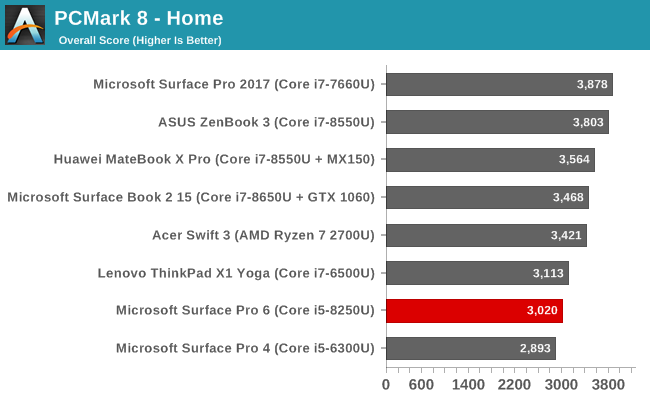
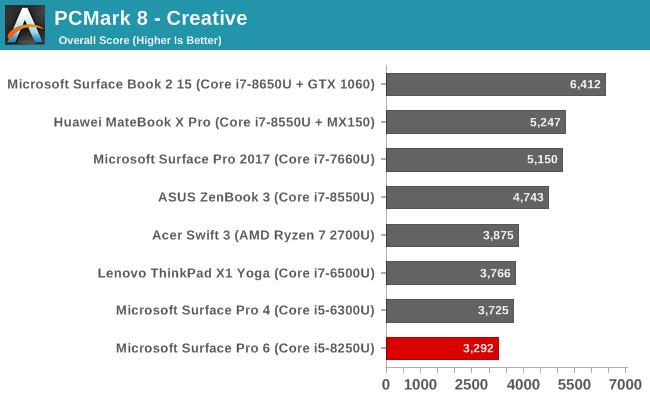
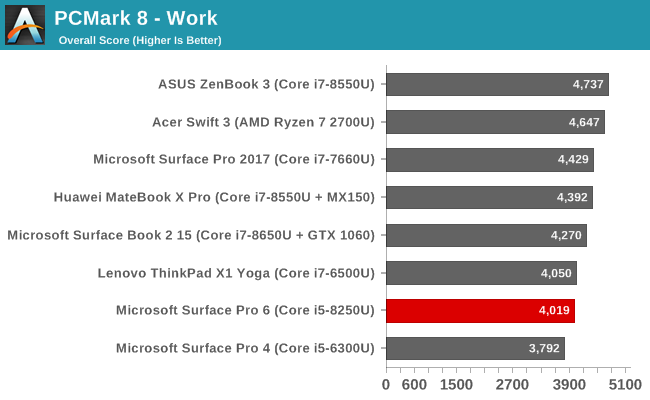
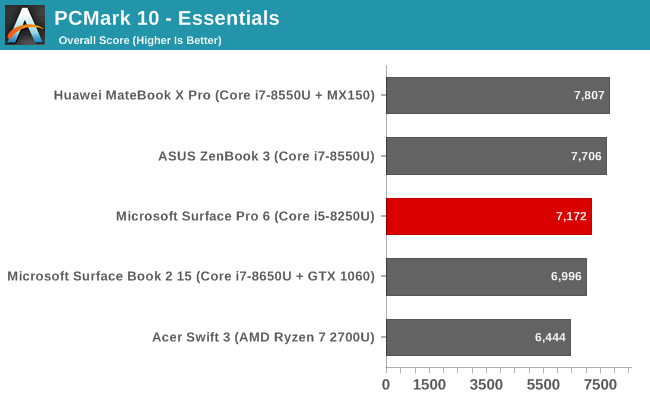
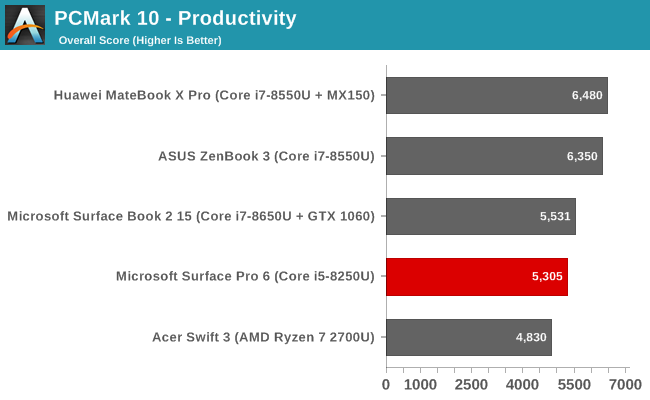
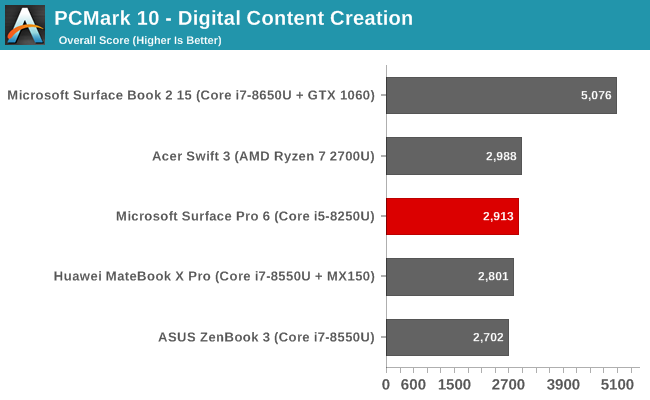
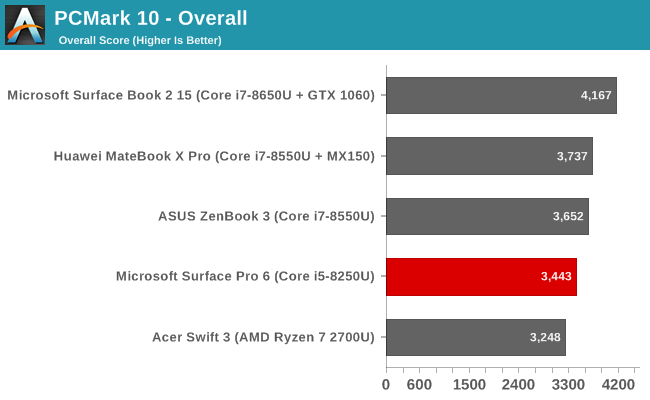
UL Benchmarks PCMark is a good tool to evaluate overall system performance, since it tests all aspects of the device. The Core i5 model can’t quite hang with the fastest Core i7 laptops around, but considering it’s the only laptop in the lineup that is passively cooled, it does remarkably well.
Cinebench
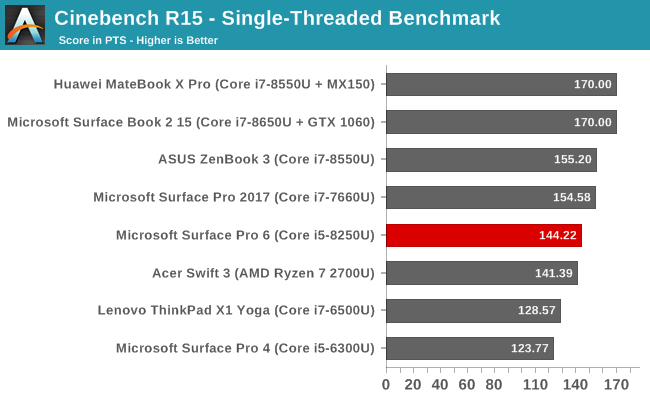
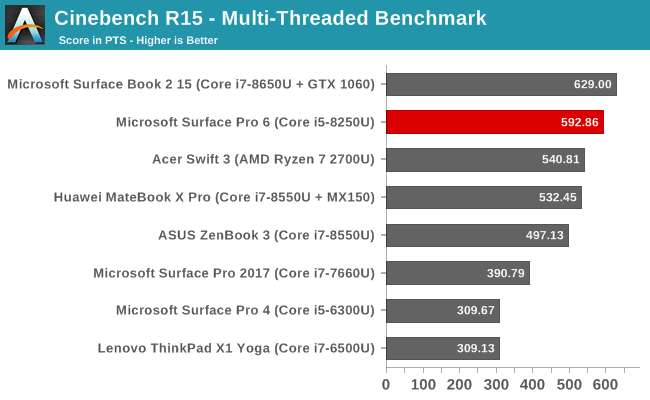
Cinebench R15 is purely CPU based test, and can be run in either single-threaded mode, or multi-threaded where more cores and higher turbo frequencies can really improve overall scores. In the single-threaded tests, the Core i5 in Surface Pro 6 is right in the middle of the pack, with it’s maximum boost frequency of just 3.4 GHz compared to a maximum boost of 4.2 GHz in a Core i7-8650U. But when you scale up the workload to multiple cores, the two extra cores and four extra threads in the Kaby Lake Refresh processor catapult it near the top, offering 66% more performance than the Core i7-7660U in last year’s Surface Pro.
x264
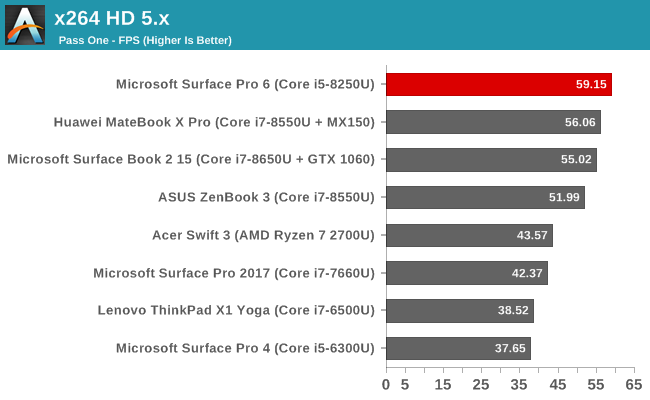
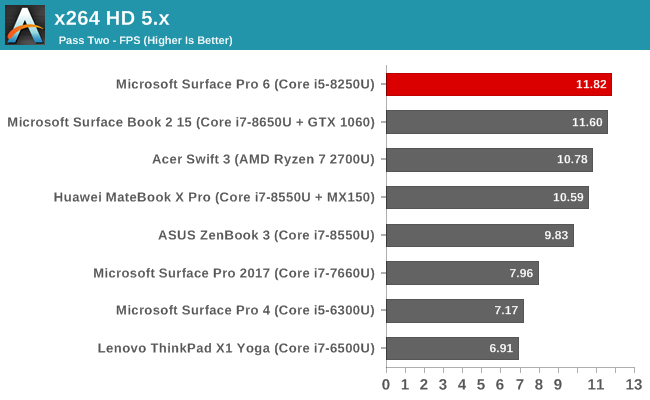
Another CPU test, x264 converts a video using the CPU, and generally scales well across more cores and threads, so the quad-core Surface Pro 6 does very well here, actually outperforming even the Core i7 in other devices. This is also quite a long test, meaning the Surface Pro 6 certainly would have run into its thermal limit, but it still offered excellent performance, meaning the passive cooling system was able to cope.
Web Tests
All of our web tests are run using the latest version of Microsoft Edge, and the Surface Pro 6 was tested on Windows 10 version 1803.
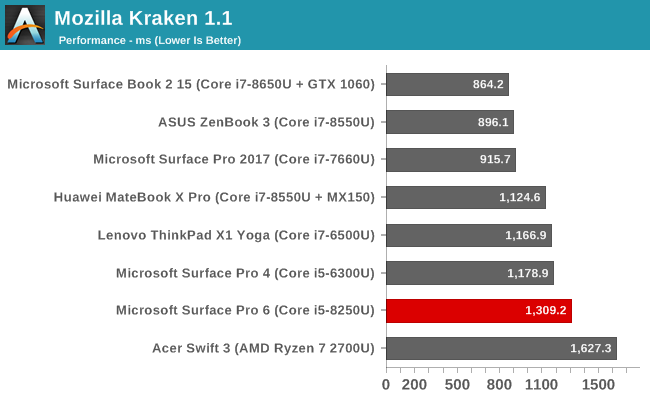
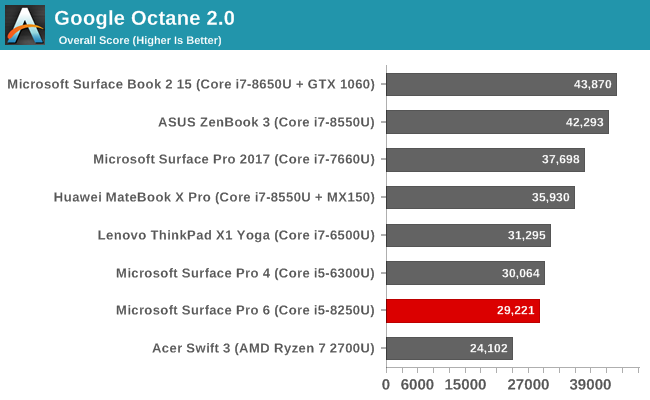
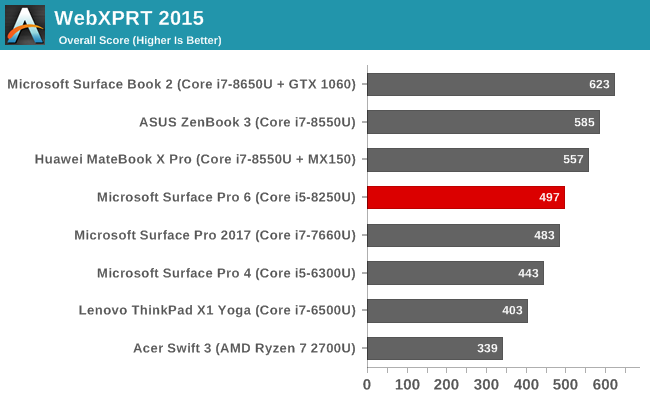
Here the Surface Pro 6’s Core i5 didn’t fare so well, with middling scores compared to the latest laptops around. Possibly due to the fanless nature, the PL2 values for the Surface Pro 6 were limited to around 23-Watts, and on other Kaby Lake Refresh devices, it’s not unusual to see 30-Watts for short bursts, and web tests tend to thrive on short bursts of performance.










80 Comments
View All Comments
Da W - Wednesday, October 17, 2018 - link
There used to have a big difference between i5 and i7 on surface. Not anymore. An i5 is enough and you will save 300$.stacey94 - Wednesday, October 17, 2018 - link
Do you guys have plans on reviewing the Laptop 2? I'd like to know more about the display calibration and throttling characteristics.Also, I wish you guys were a little harder on Microsoft about their misleading SSD dual sourcing with review and retail units. Historically (I've noticed this with the SP4, SB1, SP2017, SL1), they send reviewers a unit with a decent drive, but in retail, you'll only ever find units sold with a cacheless, slow TLC drive that doesn't even come close to the results seen in reviews. This has been passed off as lottery/dual-sourcing in the past, but I deploy these machines and follow user comments online, and have yet to find anyone who has received the "good" drive.
For example, for the first gen Surface Book, they sent reviewers units with a decent Toshiba drive, but every retail unit had the PM951 which was a truly awful drive in the 128 and 256 GB configurations since it did not have the TurboWrite from the equivalent EVO.
In the 2017 models, they sent reviewers units with a decent PM971, but almost every retail unit had the piece of junk Toshiba THNSN0128GTYA. Sometimes, in the case of Notebookcheck, they even misled the reviewers into thinking the i5 comes with the Toshiba and i7 with the PM971, but every i7 Surface Laptop I've deployed still has the crappy Toshiba drive.
Many people, especially content creators, who want a good SSD buy Surface devices and come out disappointed when they don't perform up to par with MacBooks. It's unclear to me if MS is still doing this with 2018 devices, but they really need to be called out.
SaolDan - Wednesday, October 17, 2018 - link
I actually had a surface pro 4 with the toshiba drive. The screen developed a pressure spot and i took it in to the microsoft store and i requested a replacement with the same drive and not the slow samsung drive. No one i the store had ever seen the toshiba drive. We tried 4 sp4 and they all had the samsung drive.Icehawk - Wednesday, October 17, 2018 - link
I am willing to bet the new Surface sucks in real life just as much as the previous ones. Super unreliable driving more than one monitor and I’ve just had two where the battery has swollen detaching the screen - I will say though MS was great replacing both even though their warranties ended a year earlier. Also the high rez screen SUCKS - you need a lot of scaling to use it directly or when running multiple monitors it can cause issues getting resolutions set. I have never seen anyone use it as a tablet - they are either docked or used with a keyboard. A thin & light laptop is the better solution IMO.Icehawk - Wednesday, October 17, 2018 - link
Btw my inital comment about multi monitors - Surfaces have a terrible time reliably attaching to monitors via dock. Telling execs to unplug and replug until they work is not good. All but two (we have 18 deployed) users hate them...wr3zzz - Wednesday, October 17, 2018 - link
This is why I am hesitant to purchase 3:2 screen laptops for work. 16:9 desktop monitors are the norm in workplaces and homes. 3:2 might be more practical on a small screen but 16:9 is just easier with 1:1 docking when you don't work primarily with the laptop screen.tipoo - Wednesday, October 17, 2018 - link
"The lack of an Intel Iris GPU option was unavoidable, since it no longer exists in the 15-Watt range,"Hmm. Wonder what happens to the 13" rMBP non-touchbar then.
Lew Zealand - Wednesday, October 17, 2018 - link
The 13" rMBP is still using Kaby Lake because of that.Not to worry, the Mac Mini is still using *Haswell.*
WatcherCK - Wednesday, October 17, 2018 - link
Do you still get a (time limited) free 365 subscription when buying a surface? I remember that being a thing with the older models...Duncan Macdonald - Wednesday, October 17, 2018 - link
With a non-replaceable battery these devices have a usable life of 3 years or less before they become landfill. AVOID(Ifixit gives the Surface Pro 6 a repairability score of 1 out of 10 - unrepairable)